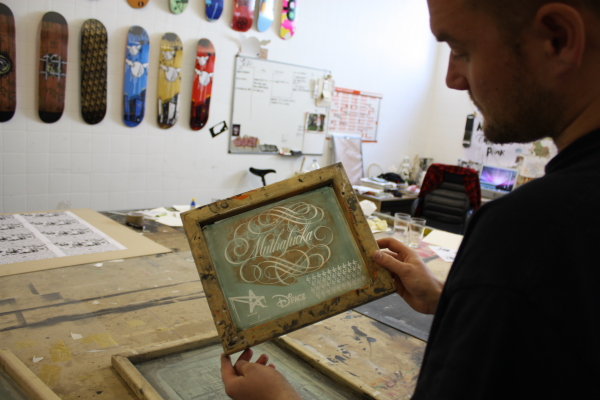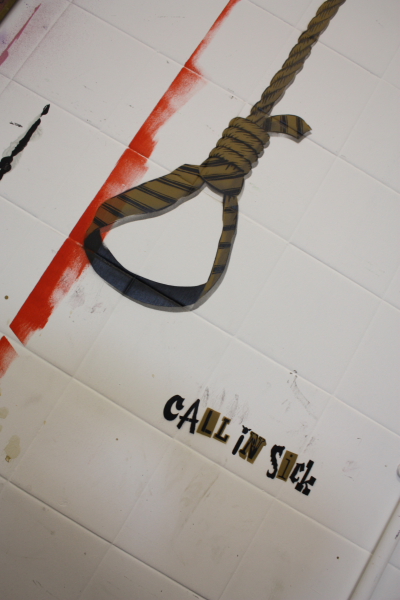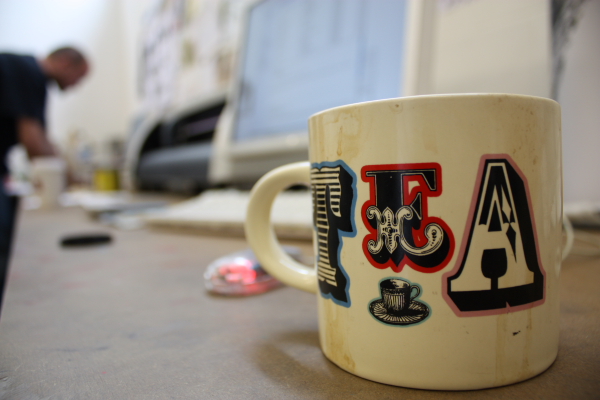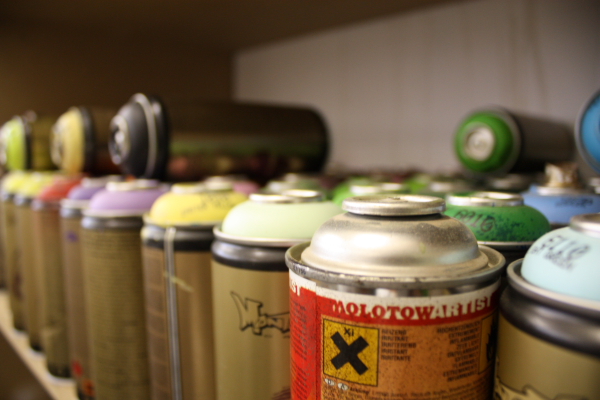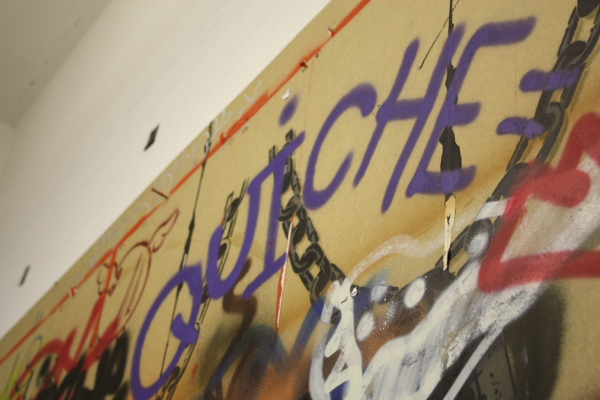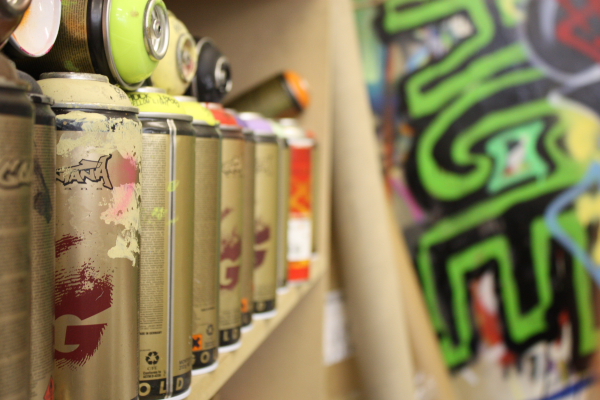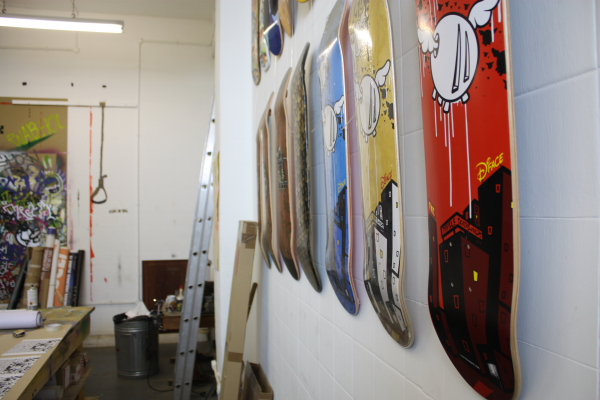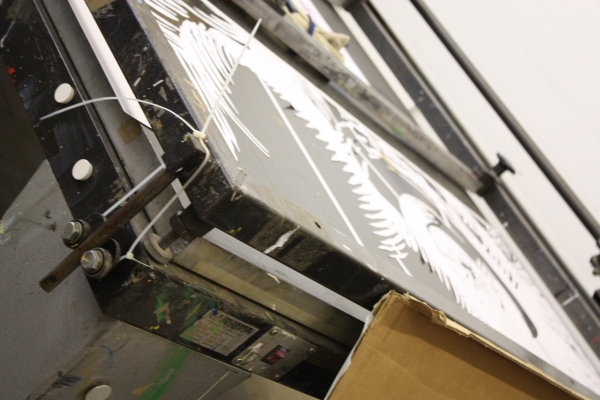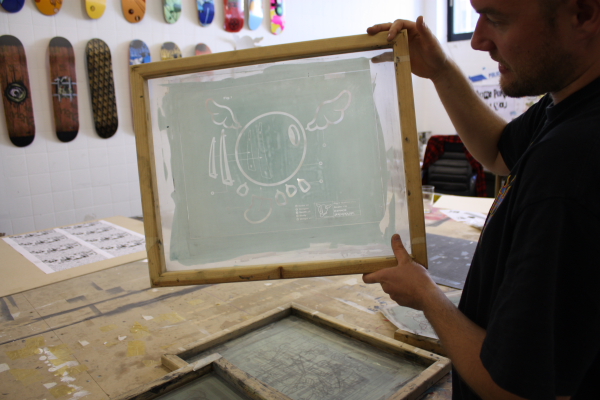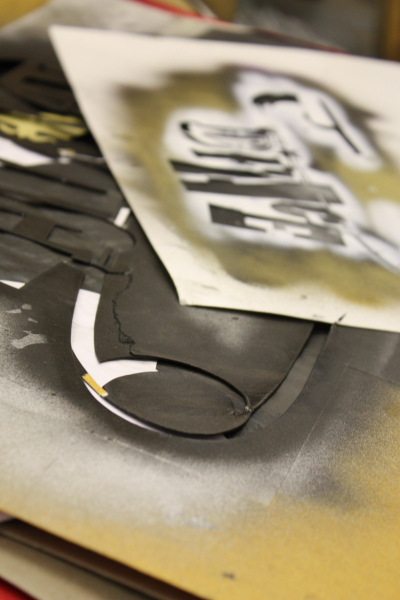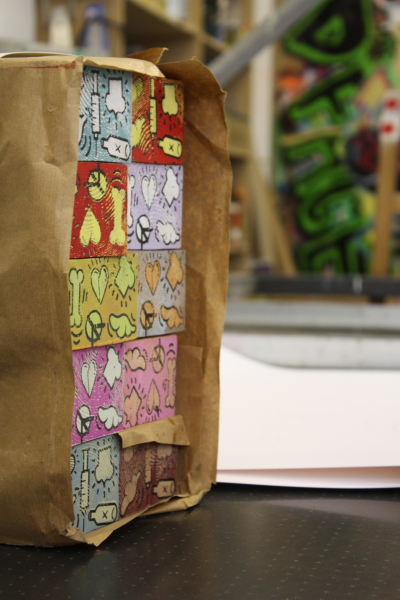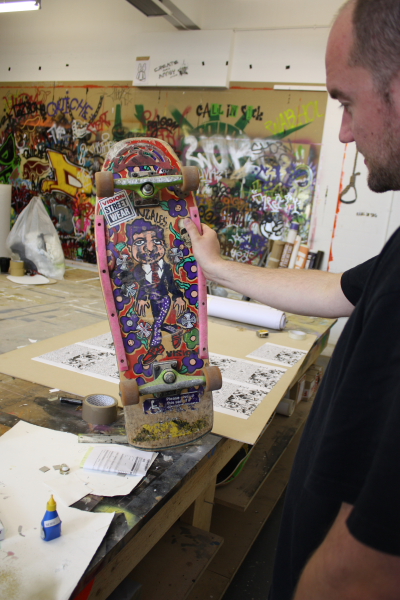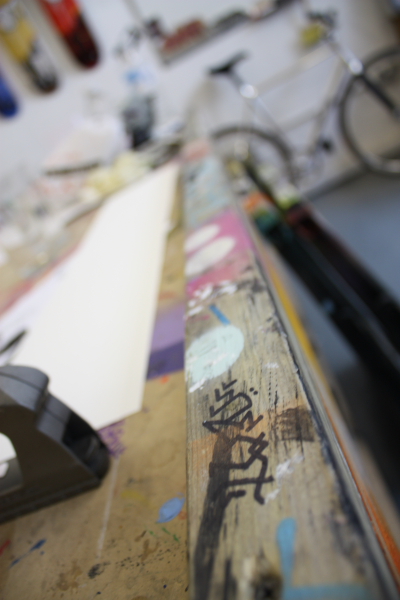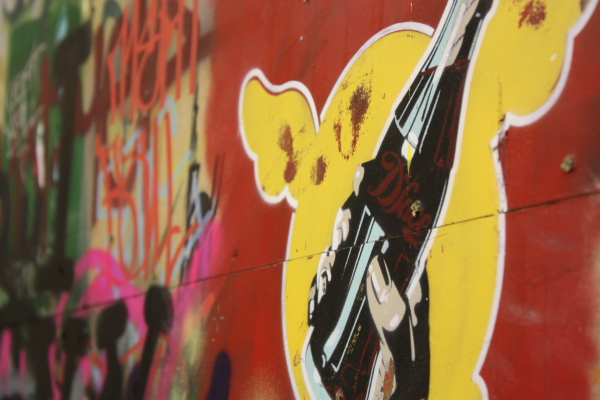D*Face is undoubtedly one of the most important artists working within the realms of street art today. His bold compositions and daring outdoor work continues to push the boundaries to new levels. AM was lucky to be invited into D’s studio to carry out an interview with the man himself, just ahead of him flying out to New York for his much anticipated solo show at Jonathan Levine Gallery “Ludovico Aversion Therapy / All Your Dreams Belong To Us” (teased). Taking part of it’s name from the treatment given to the character of Alex in Burgess/Kubrick’s classic tale of ultra-violence in “A Clockwork Orange,” we’re sure that New York will be a captive audience – but will it be able to handle D*Face’s bombardment of visual reconditioning?
D just updated his website here with a sneak view of something that will be given away to those who attend the opening. Read on for our interview and pictures after the jump…
Arrested Motion (AM): So the main reason that we’re here is to talk about your upcoming solo show in NY at Jonathan Levine Gallery – “Ludovico Aversion Therapy / All Your Dreams Belong To Us.” Are you planning on subjecting the viewers of the exhibition to some kind of aversion therapy and bombard them with graphically violent images?
D*Face (DF): Yes, the title obviously comes from “A Clockwork Orange,” and the scene where Alex has his eyes pinned open. It’s not meant to be taken literally from the title. The idea is that’s what happens anyways in our lives, whether you like it or not. Advertising is a very cruel and clever game that’s played and I’m fascinated with the things that are communicated to us and how they are communicated to us over our life cycle “daily, to yearly, to decades” and what parts of that you retain, and when and why. This is essentially a culmination of what goes on inside my head when you have that semi dream-like state where you are falling between awake and asleep and your brain is trying to decipher the day and trying to store what’s relevant and get rid of what’s irrelevant. I think that’s a really interesting concept. So the “Ludovico Aversion Therapy,” whilst your eyes aren’t being pinned open in the literal sense, is my version of what’s being deciphered. I’ve re-composed imagery that I’ve grown up with that’s just been stuck in my head somewhere and that’s come together in a body of work.
AM: So there’s no plan to play some Beethoven as “conditioning” for the musical backdrop at the opening?
DF: Ha-ha. It’d be quite nice to play Beethoven wouldn’t it? Possibly.
AM: When I first heard the title I wondered if there would be some kind of soundtrack to accompany it.
DF: Maybe I should turn up in a white boiler suit with a black bowler hat and a truncheon! I remember when I first saw “A Clockwork Orange.” A mate had a Dutch pirate copy of it and it was subtitled. There was so much talk about it.
AM: Back to the days of pirate videos and pre-certificate film…
DF: Yeah, it had to be smuggled into the country as it was banned over here. I remember watching it and thinking it’s so fucking weird. It wasn’t frightening, and it wasn’t what I expected it to be, but it got into your head and pushed a few buttons and twisted a few dials and then stayed with you. That is what is so powerful about that film. By today’s standards, it seems a bit toned down and possibly a bit naive, but when I watch that film there is an essence about it that’s really on-point even today. It may be even more relevant today than it was in it’s time.
So with Ludovico, maybe it’s a little bit cryptic, so essentially what I’m saying with that title and what I’m saying with the whole show is – All Your Dreams Belong To Us – they’re not your dreams, they’ve been given to you by what you’ve been brought up with, what you’ve been surrounded by, and it’s relevant to anyone who has grown up in a city or town where there is a prolific amount of advertising, or TV or radio. These things are out of your control, you don’t necessarily want to see or hear them but they are fed to you anyhow. I don’t want to see adverts on TV. I’d like to get rid of them, but the simple fact is that only one channel doesn’t have adverts, every other one does, so you are going to get that whether you like it or not. One minute I can be watching soldiers being killed in Afghanistan, turn it over and Britney Spears is running around LA, turn it over and it’s the WotWots on a children’s channel. How do you distinguish between one or the other? If you don’t like it you turn it over until you find something you like, but with Sky it’s like there are thousands of channels, but it’s like an endless cycle of imagery – “mostly rubbish and having a child, as you’ll know, you start to see how that’s being fed into their lives. It’s fascinating to me to see what advertising she picks up on, what she does and what she doesn’t like. But if you turn on the news, the reality is boring compared to this candy coloured world that she lives in.
AM: I had a real shock last weekend when we were at a hotel and she saw an AA sign saying how many stars the hotel had and she said “look daddy, it’s the AA only 30 minutes away!”
DF: Ha-ha. So you were like, how do you know that? Where did that come from?
AM: Yeah, but half of the adverts on the children’s channels are aimed at the adults.
DF: And I find that fascinating. Why would you put that advert in amongst the children’s programs? It’s really obvious “it not just the children watching, it’s the mums and the dads sitting there watching it as well. It’s playing directly to you. This influx of imagery – when’s it going to end? People desire imagery and communication quicker and quicker. Once upon a time, you didn’t have the internet; you’d go out and see imagery. For me growing up in London, the graffiti I saw was mainly because I was traveling around skateboarding, or from the sides of a train. With the internet you can catch it straight away – it actually lives on the internet, it doesn’t live in reality, because it’s erased so quickly. That appetite for “new” is fascinating. People want something new from an artist, a musician, whatever, and how can that appetite be sustained and fed? When does it stop? The second you get an update from twitter? You get these updates all the time, but where do you go from “all of the time?” Where do you go from “the second?” It’s an interesting thought and concept, but I don’t know the answer to it, and that’s what this body of work is about.
AM: We know that you like to produce “bodies” of work, and that you’ve been working on this show for a long time. What sort of theme does this show take on, and does it pick up in anyway where “aPOPcalypse Now” (covered) left off?
DF: Well, the aPOPcalypse show was about my childhood inspirations. Things that affected me, things that I liked, things that I didn’t like. Comics obviously played a huge part in my life, and so did pop art. So, aPOPcalypse now was essentially about what happens to those superheroes today? Those things that I grew up with were so prominent in society. Superman being this American way to invigorate the public, to boost public morale, to instigate a possible war with Russia. This one conquering power, this one person that embodies America and helps fight off the evil enemies. You know there’s a bigger story than the simple Clark Kent – this bungling office worker who comes out to save the day. People are wary of America’s “invade now and ask question later” policies. They don’t want it – we’ve seen that, and America has now seen it too.
In that body of work, there were some ideas that had been springing back and forth. The very straightforward superheroes, this idea of good versus evil. I made this rotating cube where you could use Batman’s eyes, with a balaclava’d mouth and Robin’s chin, but it was always going to create an evil being; you were never going to make a good guy even though there were good guy elements. So it was really interesting to see how good and evil are portrayed, and how that information is fed to us. For example, the story that we are told through our news channels is very different from that which the Iraqi or Afghan people are told. So there are different sides to the story with different imagery.
Another piece in the show was the motorized piece, which turned itself over where I stole advertising from bus shelters and reinterpreted them by chopping them up into strips and put them together to give another image – and that was really the birth of this new body of work. I really enjoyed making that piece. The idea of taking something and cleansing the streets from advertising, and then re-assembling something that has a new image and a completely different meaning. So really those two pieces sprung this idea of communication within a journey in a lifetime. Like you say, they are bodies of work and those particular pieces were the inspiration for the new work. It’s not to say that I won’t go back and do superheroes, but for me, it’s about taking interesting developments in my body of work. I don’t want to just sit on an idea and say that’s what I’m going to do. There is always a thread that runs through, and hopefully that’s visible to people.
AM: So this sounds like a linear “exquisite corpse” approach. Will there be a continuation of the iconography previously represented within your work?
DF: Well superheroes are still apparent, but maybe in a more disguised way. This new show has queens in it, from a much older idea. And even though I was adamant that I was not going to do any more queens, it just goes to show that the idea’s never dead if it feels right. Again it’s about reinterpretation, but it did seem to fit in terms of the colours and the mixing of imagery, so the queen does make an appearance again.
AM: Of course you used the image of the punk queen for the electronic G20 billboards.
DF: Yeah, the queen came back into it because of those billboards. Like I said, I wasn’t going to use the queen again, but it became so apparent that I should. It was the G20 summit, the queen’s head on a “£20 note” That idea was about all these anarchists that were going to descend on London, and all the media were just hyping the shit out of it, saying that London was going to be shut down, and it was shut down. Spittlefield Market which is on every Thursday just wasn’t on. I spoke to some of the market stall holders the next week and they said they weren’t allowed to set up because they thought there was going to be rioting going on, but it was like fucking miles away from where we are talking about! Whose idea was that? It was ridiculous. So again, that is what we are fed by the press. If you went down there and saw what was actually going on, there was this little circle of hardcore anarchists, then outside that was a ring of spectators, and outside them was a ring of press. 10% anarchists and 90% spectators and press. That again was really interesting to me, with what you’re being told and fed, and then when you see the pictures the next day in the newspaper (like some guy throwing a fucking chair through a window) but everyone was waiting for something to happen…
AM: Well, the reporters were stirring things up and encouraging things to kick off.
DF: Yeah, absolutely. So the point of those billboards, the queen is probably more punk than you! Who is punk and where is it being fed from? The digital billboards were a load of fun and I wanted to produce a big canvas of that. Neon colours. True punk style and that kind of fed itself naturally into this work. That will be in a different room as I don’t think it sits necessarily alongside the new body of work. I am conscious about that, but I do think it sits together in terms of concept.
AM: Yeah, I remember being in London on that day and the company I work for wanted me to do a risk assessment just to be there, but you wouldn’t even know anything was going on outside of this small area of activity.
DF: Ha-ha! That’s ridiculous! A little bubble where there was so much money and police resources put into it. It was crazy; it didn’t make any sense at all. People were being told not to wear suits to work on that day, because they might be attacked. To me that asks a bigger question – what does wearing a suit say if you shouldn’t wear it on a certain day or you could be attacked?
AM: I think I consider you as a pop artist more than a street artist, but I’m interested to know how you view yourself. Are you primarily a gallery artist who works on the street, or a street artist who shows in galleries?
DF: I just consider myself an artist, but I didn’t even start out knowing what to consider myself if that makes any sense? I was doing something because I was really fucking bored at work and I needed a way to exercise some sort of creative freedom that I wasn’t getting where I was working – I was getting paid a salary. So I was just doing this thing as a creative release. I didn’t know what it was and I didn’t know where it was going to go. It wasn’t going anywhere as far as I was concerned; it was just a bit of fun. I enjoyed drawing out these stickers at work milking the fuck out of the equipment that they had, and I suppose that was my way of hitting back as I was working for “the man.”
The stickers started and the company I was first with were quite a cool company and they kind of encouraged it. I left that company and went to work for a bigger company, which seemed like a good idea at the time, but ended up being a stupid idea but in a way I guess it forced my hand so then it was like I decided that I was going to rinse the company for every pen, every bit of paper, every photocopy as much as possibly could to put my stuff up in the street those early days. I started connecting with a few people, Shepard Fairey, The London Police and then traveling and meeting people.
I’d go to Barcelona and meet Pez, Berlin and meet Flying Fortress. You realised you weren’t the only one doing this thing; they were doing it in their individual ways. Characters and icons were quite prominent then and everyone was developing their little motif that they were putting out there. I was putting this thing around London and it was my message to my girlfriend. She’d be like “I didn’t know you’d been down there” or “I saw one of your stickers today and thought of you” and that was kinda cool. People started to pay attention to it, and then when I started to connect with people who were doing similar stuff, we saw each other’s shit everywhere.
So, it was born from boredom and a DIY mentality because I had to find a way of producing the stuff. I went from hand drawn stickers to not being able to draw enough stickers that I wanted to put up. I taught myself how to screen-print in my loft. Learnt how to expose screens – slowly things started developing. I got a few offers to show with other artists; group shows in bars, little galleries here there and everywhere. We were doing finders keepers at the time; it wasn’t like anything was going to be sold. We couldn’t ever imagine that. It was about going along to have a good time and put some stuff up. In fact with finders keepers, you were more pleased that someone would willingly take it; that was really exciting, the fact that someone likes what you’re doing.
AM: And the concept of finders keepers was that people could take a painting straight off the wall…
DF: Yeah, we’d pitch up; there would be me, Mysterious Al, PMH and Dave the Chimp. Me and PMH had the idea of doing this weird free gallery. We’d find a spot that would be in some derelict run-down area. First it was Old Street, back then it was run down – there were none of the bars that there are now. We’d email a few artists and say we’re doing this show, painting on found objects, its all about no money. We don’t want you to spend any money on canvases, we want you to paint them in a week, not spend a month creating something for it not to be taken, then pitch up here at 5 o’clock on Friday evening, bring beer, bring music and we’ll put the work in the space.
Then on Friday morning we’d email people that we knew that had an interest saying there was a free gallery – come down and take the art! We did a few of those and it just snowballed and got bigger and bigger. The first was brilliant; second was great; third was cool, but the fourth one started getting a bit awkward because people started getting wind of it and we got the wrong people turning up. People in suits thinking I’m gonna get a free piece of art tonight. They’re earning money and we’re all struggling and flat broke. It started to grate a bit, so we decided to see how we could reinvent that. But it was a journey and all part of the process.
So, as I said before now I consider myself to be an artist. I don’t consider myself to be a street artist, and not necessarily a gallery artist, but I’m given opportunities to exhibit my work; and whether that’s in a public space illegally, or a private space legally I try and treat them in their respectful ways. I love putting something up in the street, it’s something I’ve always loved doing and I hope to continue doing it. As I get busier with gallery shows, I find less time to go out and do the stuff on the streets, and that’s not because I don’t want to do it, just because I have less time to do it. Plus, some things I’d like to execute in the street, I have yet to find how to execute them in the street. There is a process of working, and I don’t want to just go out and do stencils in the street; there’s one person doing that well enough for everybody.
AM: The things you do on the streets these days, there’s a lot of logistics behind them like the digital billboards, like the concrete spray cans, it must take some serious planning.
DF: I’d rather do one good thing a year than do fifteen things that you’ve already seen before. I’d love to be able to do fifteen things that are absolutely bang on point and hard hitting, but the reality is that it’s not possible. I’m going out to New York and I’m trying to hook up some stuff out there – whether that be legal or illegal, I like putting work in a public space; and the thing about that is you are bringing work to a group of new people that they wouldn’t ever necessarily know about, and that has always been what it’s about.
AM: Screen-printing seems to be important to you as a medium for your artistic output – we’ve even seen you screening images onto outside walls. What in particular attracts you to the use of screens?
DF: I really like the process of transferring an image on to a screen and then inking the image onto an object. I can get the results that I want. It’s something that I’ve developed over the course of trying various ways of doing it. When I didn’t have the facilities, I used to go to great effort to meticulously draw out everything by hand, even if it was super detailed and complicated – I was never really satisfied with those results, so the development of screen printing for me just seemed to be a perfect solution to produce certain elements of my work but not all of it. It’s just a really great flexible process and whilst it’s age-old, it still has life in it. There’s nothing like pulling that first squeegee across the ink and seeing that image come out as you’ve intended – it still gives me a buzz now. The screen printing of images onto walls was something that I actually did really early on in the development of my work. I was thinking I’m screen printing stickers, and they are just getting pulled down by people… why can’t I just screen print directly onto things? So I went out one night and did it, and it worked really well. I did it a couple more times and got absolutely fucking covered in ink! I can be a really dirty process and you have to be careful about where you apply it and how you apply it…
AM: Well, it’s a very horizontal medium…
DF: Yeah, you’ve got a whole bunch of things going on all trying to work against the laws of gravity, but I’ve got a good method now and its fairly simple. I like doing stencils, and I still will do stencils, but I don’t want to be a stencil artist. The whole thing with stencil art trying to make a piece as photographic as possible, which people try and do, well I thought I’d just do a screen – it’s super clean and super fine detail – way more than you could ever get with a good stencil – and I can repeat it instantly if I get it correct. When I went to San Francisco, I had this little suitcase that houses the screens, ink and a squeegee so you can look as inconspicuous as possible. Try and keep as clean as possible was the main thing I learned from it…
AM: Well that’s how you could get caught red-handed…
DF: Quite literally yeah, or black-handed as it were.
AM: You wear many different hats in your day to day life – artist, gallery owner, curator, designer, sculptor and so on. Which element do you enjoy the most?
DF: I thought you were going to ask is there anything you hate! All of the things I do because I want to do them, so they are all love! I really enjoy sculpture. It’s something that takes time and I’m not a particularly patient person and it tends to slow down what I’m doing, but it develops what I’m doing in a different context. There’s something historical about sculpture as well. I like elements of running a gallery, the curating process and the ability to help show artists and help them find their voice. It’s a really good thing when you’ve shown artists first and they’ve gone on to be successful. That is really inspirational thing for me to be able to do. It comes with its downsides though – it’s super stressful, but I still enjoy it.
AM: So which is the part that drags the most?
DF: The business bullshit that goes with running a gallery. But that comes with anything that involves people and money. The day to day grind can be quite time consuming and frustrating.
AM: The guys at Arrested Motion love both the street art and the lowbrow / newbrow / pop surrealism movements. Lots of the US based galleries that we like seem to tread happily between the two genres. With your gallery, StolenSpace, you seem to broach the acceptance of the two movements side by side much more than other UK galleries. You have Sylvia Ji showing next (covered). Do you think that the genre has an audience in the UK?
DF: Well, I don’t like the word lowbrow, because it supports the word highbrow, which I hate even more! It certainly undermines the brilliance of the artists and I don’t know why people persist in using that fucking term. People that are put into that term don’t like it either. I’ve never considered the gallery to be a lowbrow gallery, just an art gallery. It was created to bridge the gap between the galleries where I wasn’t welcome and the art I’d see on my travels around as an artist, plus knowing the artists I was meeting and they didn’t have a space to exhibit their work; and if they did, it was not handled in the most professional way. I want to treat my artists in the best possible way.
I had the stupid idea of doing it twice. First I opened the Outside Institute. Elms Lester was the first gallery to be showing street art and graffiti, predominantly with an English lead. We ran Outside Institute for a year and it was just literally killing me. I closed it down and reopened StolenSpace, but in the right way, based upon a better understanding of how to run a gallery. We’ve been doing that for 3 years now. It works, and it’s inspirational. What I’ve always tried to do with StolenSpace, and I’m not the only person involved in StolenSpace by any means, is try to show young artists, fresh artists that have the thread or spirit of StolenSpace as a concept, as an idea of a gallery. It’s not really about lowbrow or street art, but more about prevailing sub-cultures that have been left outside and never been given the time of day in the gallery world that existed prior to this. We tried to give tattoo artists, skateboard artists, illustrators, comic book artists, graffiti artists and street artists a place that they could call home really; hang out and show their art.
AM: I find that a lot of people who appreciate the sub-cultures of street art and newbrow come from some kind of background involving either the punk / hardcore scene, hip-hop or skating. I know that you used to skate and were into the punk scene, as was I in the late 80’s and nineties. As we’re both a bit older now, do these subcultures continue to inspire and influence you?
DF: It’s funny because I look back on those days and the times were so vibrant. It was the same for the street art scene 5 years ago – there was an essence of something going on, but nobody quite knew what it was or how to define it. It was an exciting time and I can only equate it to when I used to skate back in the 80’s. Wide boards and half pipes; everyone trying to push it forward. It was a really exciting time to be a teenager.
Same with the music scene. I liked punk music and grunge music. You see it now in different movements that are happening. Those prevailing sub-cultures is what it’s about and whether you are our age, in your thirties, or whether you’re 18, if you get into them at a certain age, they give you a spirit and energy that you’ll never forget. I’m still interested in skateboarding and I’m hoping to get the skateboard out in New York. In a way skateboarding has lost a bit of what it was about for me – it was about DIY skate companies and skaters being a little bit punk – but it’s become a multi million pound business. There’s nothing wrong with that as long as you don’t lose the spirit. I know the guys that do Slam, and they are very passionate and have that spirit about them. When you see the major corporates stepping into anything and polluting it or leading it off into different directions…
AM: But there’s always people there who have that DIY spirit that take it back to grass roots level…
DF: Exactly. I mean even if it goes off on some multi-billion pound direction it’s still going to come back to where it started. It’s always interesting to see how something can be reborn through the second, third and fourth generations who pick it up. It’s the same with track bikes at the moment. People are building single speed or fixed gear bikes. A year ago when I started riding them the tricks were quite basic, but now the kids that are doing it are doing amazing tricks. A year ago you wouldn’t have thought it was possible, but just like anything it needs to be nurtured and looked after…
AM: It looks as though you have a couple of killer rides. The one you came in on this morning and then this one in the studio.
DF: Yeah, Andy at Fixed Gear London built the bike downstairs. I ride it at least 14 miles everyday. I’ve been accumulating parts to build a bike and this one I stripped down and polished and built myself. I don’t really ride it that much to be honest and that’s why it’s in here – it’s got a raw aluminum frame which tarnishes really quickly so it’s not that practical, but I’ve always been into those types of sub-cultures and I’m building a Café Racer at the moment. That’s one of the earliest forms of sub-culture, when there really wasn’t a sub-culture scene. The rockers would build these bikes and race them. Even though that was happening back in the sixties, when you look into it; it’s very relevant to the punk movement, skateboarding – it has a spirit and an ethic…
AM: And that has been carried though by people are into that movement now and they propagate those scenes…
DF: It’s interesting to see the rebirth of these scenes and how they develop. There will always be people who take the attitude that you’re not doing it right and they try and dismiss certain aspects of the new birth of the culture, but to me it’s all about pushing it forward, you know?
AM: What sort of bands did you used to like, and what do you listen to now? Is music still a big part of your life and an inspiration for your creativity?
DF: The bands I was into when I was a kid, the first album I bought was Suicidal Tendencies’ “Join The Army.” I was a massive fan of Dead Kennedys. Mudhoney I really liked, Hole, Nirvana – I guess all though their career actually. Predominantly “Bleach” when that came out, and Hip Hop when I was at school – I was into the Electro albums…
AM: Ah yeah, Electro 3 was my favourite…
DF: Roxanne Shante, all of that, again there was of spirit of something underground breaking through. Then when I was old enough to go see concerts, Gaye Bykers On Acid. Loads and loads of bands. Today I still listen to that music now. I still listen to Dead Kennedys. Bands that I like today – I really like Interpol. The new album by The XX. I like to mix it up – anything with a good tune and a good spirit. My assistant listens to northern soul, and I can get that as well.
AM: You’ve shown work with Jonathan Levine previously in the “Streets of Europe” exhibition. How did you first hook up with Jonathan?
DF: He emailed me asked “would you like to be in a show I’m doing.” He was interested who I would put in the show if I was going to curate it. I think he’d already decided his artists, but just wanted to see if I would choose any of the artists he’d picked. Then he came to London, and I had a show on in Brighton at the time so I took him down to the show and there and then he wanted to do a solo show. I said yeah for sure. Then he came over for Shepard’s show at StolenSpace. I had the aPOPcalypse Now show in 2008 and I wasn’t able to do anything that year. He kept offering me dates and I kept having to turn them down and told him that I couldn’t give him the show I wanted to give him. I think he kept getting fed up with me and said “I don’t get this problem with any other artists” (laughs). But I wanted to give him a show that I thought he should have. We finally locked down on September of this year.
AM: So after recent shows in Hong Kong (covered)Â and Melbourne – will this be your first solo outing in the United States?
DF: I had a two man show at Upper Playground before, but this is the first solo show in the US. It’s gonna be interesting.
AM: We know that you are planning on putting up some outdoor work whilst in NY. Care to let us in on any of your plans?
DF: In truth, nothing too fucking hardcore! I’m not dropping concrete cans in the streets on New York – that ain’t gonna happen. I can’t risk getting arrested for something like that. In America, it would carry a much heavier sentence than over here, so in honest truth, it will be much more basic. We’ll find a couple of spots to paint – legally or illegally. Hopefully, I’m going to paint a few box vans. I think they are intrinsically New York, and I’ve always wanted to paint one.
AM: When you went out to SF before, you went with Word To Mother (interviewed). I presume that he’s not going out with you this time but Tab will be there…
DF: Yeah, Word To Mother was at that time, part working with me as he developed himself as an artist and was getting his gallery shows together. I knew that he had to go and do his thing full time. I couldn’t be getting him in here to help me out and hold him back from developing as an artist. I had Tab working with me simultaneously towards the aPOPcalypse Now show. It was just logical that Word To Mother would go and develop his own thing and be the artist he was always going to be. He was the best assistant you could ever want – a loyal hard working good guy, and he could put up with me being grumpy and irritable most of the time (laughs). So he can’t make it over, which is a shame as me and Word like rolling together. We have a similar outlook and mentality. Good times.
AM: Mark Dean Veca (interviewed) has a solo show alongside yours at JLG. Do you like his work and are you looking forward to showing with him?
DF: Yeah, I’m really looking forward to showing with him. I love his stuff actually. I met him when I was in the “Streets of Europe” show. I asked him if he liked Jim Phillips and he didn’t know him. I said I thought you’d be really inspired by him – he was the best skateboard artist ever…
AM: Yeah he did those really intestinal works too.
DF: That’s right. He said he’d heard his name, but wasn’t really inspired by him at all. Then Jonathan asked me if I’d be happy to show alongside Mark, and I was like, absolutely. I love what he does – his stuff’s sick. And it’s similar but dissimilar to what I do. I think it sits comfortably alongside what I’m about and mine – what he’s about.
AM: Post Levine, what can we expect from D*Face for the remainder of 2009 and into 2010?
DF: 2009 I’m going to LA in November. Then I’m having a year off and I’m not going to do fuck all for a year! (laughs). I’m doing a show in LA in 2010 but it’s going to be next year, not until the end of next year, if not then the beginning of 2011. That’s all potentially because there are question marks hanging over it, like when, where and how long for, what size and scale and who for. That’s the next thing. I’m working with some guys in LA to make that happen. I guess that will be the LA equivalent of aPOPcalypse Now, but it will be bigger scale with more installation. I want to go to LA and do some shit. The last time I went there, it was so brief I didn’t get chance to do some work out there.
AM: There’s a great buzz about LA…
DF: I like LA. It’s everything my work is ‘anti’ embodied in a city. Lala land – that name fits it brilliantly. So I’m looking forward to LA. I’m definitely going there this year.
AM: Thanks for your time D. We wish you every success in New York.
DF: Thanks very much.
- An early screen. Note the different shaped wings.
- D`s First skateboard



